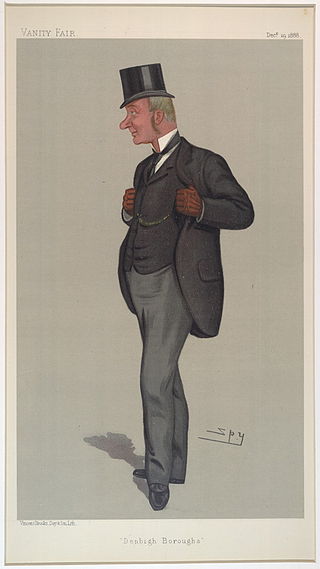
Sir John Lawrence Baird of Urie, 1st Viscount Stonehaven, 1st Baron Stonehaven, 2nd Baronet, 3rd of Ury, was a British politician who served as the eighth Governor-General of Australia, in office from 1925 to 1930. He had previously been a government minister under David Lloyd George, Bonar Law, and Stanley Baldwin.
The Peerage of the United Kingdom is one of the five Peerages in the United Kingdom. It comprises most peerages created in the United Kingdom of Great Britain and Ireland after the Acts of Union in 1801, when it replaced the Peerage of Great Britain. New peers continued to be created in the Peerage of Ireland until 1898.

Lloyd Kenyon, 1st Baron Kenyon,, was a British politician and barrister, who served as Attorney General, Master of the Rolls and Lord Chief Justice. Born to a country gentleman, he was initially educated in Hanmer before moving to Ruthin School aged 12. Rather than going to university he instead worked as a clerk to an attorney, joining the Middle Temple in 1750 and being called to the Bar in 1756. Initially almost unemployed due to the lack of education and contacts which a university education would have provided, his business increased thanks to his friendships with John Dunning, who, overwhelmed with cases, allowed Kenyon to work many, and Lord Thurlow who secured for him the Chief Justiceship of Chester in 1780. He was returned as the Member of Parliament (MP) for Hindon the same year, serving repeatedly as Attorney General under William Pitt the Younger. He effectively sacrificed his political career in 1784 to challenge the ballot of Charles James Fox, and was rewarded with a baronetcy; from then on he did not speak in the House of Commons, despite remaining an MP.

Baron Kenyon, of Gredington, in the County of Flint, is a title in the Peerage of Great Britain. It was created in 1788 for the lawyer and judge Sir Lloyd Kenyon, 1st Baronet. He served as Master of the Rolls and as Lord Chief Justice of England and Wales. Kenyon had already been created a Baronet, of Gredington in the County of Flint, in 1784. His grandson, the third Baron, briefly represented St Michael's in the House of Commons. His grandson, the fourth Baron, held minor office in the governments of Lord Salisbury, Arthur Balfour and David Lloyd George and also served as Lord Lieutenant of Denbighshire. In 1912 Lord Kenyon assumed by Royal licence the additional surname of Tyrell. As of 2023 the titles are held by his great-grandson, the eighth Baron, who succeeded his brother in that year.
Baron Mostyn, of Mostyn in the County of Flint, is a title in the Peerage of the United Kingdom. It was created in 1831 for Sir Edward Lloyd, 2nd Baronet, who had earlier represented Flint Boroughs and Beaumaris in the House of Commons. His son, the second Baron, sat as a Member of Parliament for Flintshire and Lichfield and served as Lord Lieutenant of Merionethshire.

Peter Garth Palumbo, Baron Palumbo is a property developer and art collector. Palumbo was the last chairperson of the Arts Council of Great Britain and a life peer. He sat as a Conservative in the House of Lords from 1991 to 2019.

Richard Hugh Cavendish, Baron Cavendish of Furness, is a British Conservative politician and landowner.
This is a list of people who have served as Lord Lieutenant of Flintshire. Since 1802, all Lord Lieutenants have also been Custos Rotulorum of Flintshire. The office was abolished on 31 March 1974, and was replaced by the Lord Lieutenant of Clwyd.
This is an incomplete list of people who served as Lord Lieutenant of Denbighshire in Wales. After 1733, all Lord Lieutenants were also Custos Rotulorum of Denbighshire. The office was abolished on 31 March 1974, being replaced by the Lord Lieutenant of Clwyd.

John Archibald Boyd-Carpenter, Baron Boyd-Carpenter, PC, DL was a British Conservative politician.

Penley is a village in the County Borough of Wrexham, in Wales close to the border with Shropshire, England, and had a population of 606 as of the 2011 census.
This article is about the particular significance of the year 1924 to Wales and its people.
This article is about the particular significance of the year 1923 to Wales and its people.
This article is about the particular significance of the year 1918 to Wales and its people.

Lloyd Tyrell-Kenyon, 4th Baron Kenyon, KCVO, TD, was a British peer and Conservative politician.
This article is about the particular significance of the year 1893 to Wales and its people.
This article is about the particular significance of the year 1864 to Wales and its people.

George Thomas Kenyon was a British Conservative Party politician who sat in the House of Commons in two periods between 1885 and 1906.

Tudor Court is a house 0.5 miles (1 km) south of the village of Penley, Wrexham, Wales. It was originally called Llannerch Panna.
This article is about the particular significance of the year 1732 to Wales and its people.










